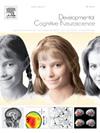Longitudinal habituation and novelty detection neural responses from infancy to early childhood in The Gambia and UK
IF 4.9
2区 医学
Q1 NEUROSCIENCES
引用次数: 0
Abstract
As infants and young children learn from and respond to their environment, their development is driven by their ability to filter out irrelevant stimuli and respond to salient stimuli. While sources and types of stimuli vary across cultural contexts, research to understand the neural mechanisms of these behaviors have largely focused on relatively homogeneous populations in high income settings. To address this lack of diverse representation the Brain Imaging for Global health project (BRIGHT) collected longitudinal data in The Gambia (N = 204) and the UK (N = 61). Here we present results of the Habituation and Novelty Detection (HaND) fNIRS neuroimaging task. Gambian infants showed persistent response suppression (Habituation) at all visits (from 5mo to 60mo) while Novelty Detection was only observed once infants reached 18 and 24mo. In the UK, infants only showed persistent habituation from 5 to 12mo, while the response was not evident at 18 and 24mo. Furthermore, in contrast to The Gambia, alongside the habituation patterns observed Uk infants showed novelty detection from 5 to 12mo. This is the first longitudinal description of the HaND response in individuals from different contextual backgrounds across such a broad age range and number of time points, revealing different patterns of specialization in The Gambia and UK.
纵向习惯和新奇检测神经反应从婴儿期到幼儿期在冈比亚和英国。
当婴幼儿从他们的环境中学习并做出反应时,他们的发展是由他们过滤不相关刺激和对显著刺激做出反应的能力驱动的。虽然刺激的来源和类型因文化背景而异,但了解这些行为的神经机制的研究主要集中在高收入环境中相对同质的人群。为了解决这一缺乏多样化代表性的问题,脑成像促进全球健康项目(BRIGHT)在冈比亚(N = 204)和英国(N = 61)收集了纵向数据。在此,我们介绍了习惯化和新颖性检测(HaND)近红外神经成像任务的结果。冈比亚婴儿在所有访问中(从5个月到60个月)都表现出持续的反应抑制(习惯化),而新奇检测仅在婴儿达到18和24个月时观察到。在英国,婴儿仅在5至12个月期间表现出持续的习惯,而在18和24个月时则不明显。此外,与冈比亚相比,除了观察到的习惯模式外,英国婴儿在5到12个月期间表现出新奇感。这是第一次对来自不同背景的个体在如此广泛的年龄范围和时间点上的HaND反应进行纵向描述,揭示了冈比亚和英国不同的专业化模式。
本文章由计算机程序翻译,如有差异,请以英文原文为准。
求助全文
约1分钟内获得全文
求助全文
来源期刊

Developmental Cognitive Neuroscience
NEUROSCIENCES-
CiteScore
7.60
自引率
10.60%
发文量
124
审稿时长
6-12 weeks
期刊介绍:
The journal publishes theoretical and research papers on cognitive brain development, from infancy through childhood and adolescence and into adulthood. It covers neurocognitive development and neurocognitive processing in both typical and atypical development, including social and affective aspects. Appropriate methodologies for the journal include, but are not limited to, functional neuroimaging (fMRI and MEG), electrophysiology (EEG and ERP), NIRS and transcranial magnetic stimulation, as well as other basic neuroscience approaches using cellular and animal models that directly address cognitive brain development, patient studies, case studies, post-mortem studies and pharmacological studies.
 求助内容:
求助内容: 应助结果提醒方式:
应助结果提醒方式:


